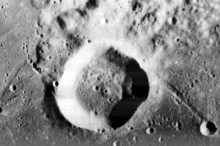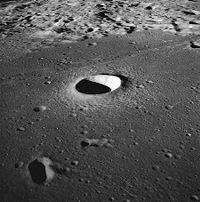
Lunar crater locations
Encyclopedia


Impact crater
In the broadest sense, the term impact crater can be applied to any depression, natural or manmade, resulting from the high velocity impact of a projectile with a larger body...
s on Earth
Earth
Earth is the third planet from the Sun, and the densest and fifth-largest of the eight planets in the Solar System. It is also the largest of the Solar System's four terrestrial planets...
's Moon
Moon
The Moon is Earth's only known natural satellite,There are a number of near-Earth asteroids including 3753 Cruithne that are co-orbital with Earth: their orbits bring them close to Earth for periods of time but then alter in the long term . These are quasi-satellites and not true moons. For more...
. The Moon's surface is saturated with craters, almost all of which were formed by impacts.
History
The word crater adopted by Galileo from the LatinLatin
Latin is an Italic language originally spoken in Latium and Ancient Rome. It, along with most European languages, is a descendant of the ancient Proto-Indo-European language. Although it is considered a dead language, a number of scholars and members of the Christian clergy speak it fluently, and...
word for cup. Galileo built his first telescope in late 1609, and turned it to the Moon for the first time on November 30, 1609. He discovered that, contrary to general opinion at that time, the Moon was not a perfect sphere, but had both mountains and cup-like depressions, the latter of which he gave the name craters.
Scientific opinion as to the origin of craters swung back and forth over the ensuing centuries. The competing theories were (a) volcanic eruptions blasting holes in the Moon, (b) meteoric impact, (c) a theory known as the Welteislehre
Welteislehre
Welteislehre , also known as Glazial-Kosmogonie is a pseudoscientific cosmological theory proposed by Hans Hörbiger, an Austrian engineer and inventor and respected steam engine designer, whose invention of the Hörbiger valve made him a wealthy man.Hörbiger did not arrive at his theory through...
developed in Germany between the two World Wars which suggested glacial action creating the craters.
Evidence collected during the Apollo Project and from unmanned spacecraft of the same period proved conclusively that meteoric impact, or impact by asteroids for larger craters, was the origin of almost all lunar craters, and by implication, most craters on other bodies as well.
Characteristics
Because of the Moon's lack of water, and atmosphereAtmosphere
An atmosphere is a layer of gases that may surround a material body of sufficient mass, and that is held in place by the gravity of the body. An atmosphere may be retained for a longer duration, if the gravity is high and the atmosphere's temperature is low...
, or tectonic plates
Tectonic Plates
Tectonic Plates is a 1992 independent Canadian film directed by Peter Mettler. Mettler also wrote the screenplay based on the play by Robert Lepage. The film stars Marie Gignac, Céline Bonnier and Robert Lepage.-Plot summary:...
, there is little erosion, and craters are found that exceed two billion years in age. The age of large craters is determined by the number of smaller craters contained within it, older craters generally accumulating more small, contained craters.
The smallest craters found have been microscopic in size, found in rocks returned to Earth from the Moon. The largest crater called such is about 360 kilometres (223.7 mi) in diameter, located near the lunar South Pole. However, it is believed that many of the lunar maria
Lunar mare
The lunar maria are large, dark, basaltic plains on Earth's Moon, formed by ancient volcanic eruptions. They were dubbed maria, Latin for "seas", by early astronomers who mistook them for actual seas. They are less reflective than the "highlands" as a result of their iron-rich compositions, and...
were formed by giant impacts, with the resulting depression filled by upwelling lava
Lava
Lava refers both to molten rock expelled by a volcano during an eruption and the resulting rock after solidification and cooling. This molten rock is formed in the interior of some planets, including Earth, and some of their satellites. When first erupted from a volcanic vent, lava is a liquid at...
.
Craters typically will have some or all of the following features:
- a surrounding area with materials splashed out of the ground when the crater was formed; this is typically lighter in shade than older materials due to exposure to solar radiation for a lesser time
- raised rim, consisting of materials ejected but landing very close by
- crater wall, the downward-sloping portion of the crater
- crater floor, a more or less smooth, flat area, which as it ages accumulates small craters of its own
- central peak, found only in some craters with a diameter exceeding 16 miles (25.7 km); this is generally a splash effect caused by the kinetic energy of the impacting object being turned to heat and melting some lunar material.
Lunar crater categorization
In 1978, Chuck Wood and Leif Andersson of the Lunar & Planetary Lab devised a system of categorization of lunar impact craters.They used a sampling of craters that were relatively unmodified by subsequent impacts, then grouped the results into five broad categories. These successfully accounted for about 99% of all lunar impact craters.
The LPC Crater Types were as follows:
- ALC — small, cup-shaped craters with a diameter of about 10 km or less, and no central floor. The archetypeArchetypeAn archetype is a universally understood symbol or term or pattern of behavior, a prototype upon which others are copied, patterned, or emulated...
for this category is 'Albategnius CAlbategnius (crater)Albategnius is an ancient lunar impact crater located in the central highlands. It is named after the Muslim astronomer and scientist Al-Battani. The level interior forms a "walled plain", surrounded by the high, terraced rim. The outer wall is somewhat hexagon-shaped, and has been heavily eroded...
'. - BIO — similar to an ALC, but with small, flat floors. Typical diameter is about 15 km. The lunar crater archetype is BiotBiot (crater)Biot is a small, bowl-shaped lunar crater located in the southern reaches of the Mare Fecunditatis. It is a circular formation with a sharp-edged rim that has not been significantly worn. The inner walls slope down to a relatively small interior floor. The albedo of the wide inner walls is higher...
. - SOS — the interior floor is wide and flat, with no central peak. The inner walls are not terraced. The diameter is normally in the range of 15–25 km. The archetype is SosigenesSosigenes (crater)Sosigenes is a lunar impact crater on the west edge of Mare Tranquillitatis. It lies to the east of the large walled plain Julius Caesar. The crater rim has a high albedo, making it relatively bright. It has a small central rise at the mid-point of the floor....
. - TRI — these complex craters are large enough so that their inner walls have slumped to the floor. They can range in size from 15–50 km in diameter. The archetype crater is TriesneckerTriesnecker (crater)Triesnecker is a prominent lunar impact crater that is located in the Sinus Medii, near the central part of the Moon's near side. It is located to the north-northwest of the crater Rhaeticus, and to the east-southeast of the flooded Murchison....
. - TYC — these are larger than 50 km, with terraced inner walls and relatively flat floors. They frequently have large central peak formations. TychoTycho (crater)Tycho is a prominent lunar impact crater located in the southern lunar highlands, named after the Danish astronomer Tycho Brahe . To the south is the crater Street; to the east is Pictet, and to the north-northeast is Sasserides. The surface around Tycho is replete with craters of various sizes,...
is the archetype for this class.
Beyond a couple of hundred kilometers diameter, the central peak of the TYC class disappear and they are classed as basins.
Beginning in 2009 Dr. Nadine Barlow of Northern Arizona University began to convert the Wood and Andersson lunar impact-crater database into digital format.
Dr. Barlow is also creating a new lunar impact crater database similar to Wood and Andersson's, except her's will include all impact craters greater than or equal to five kilometers in diameter and is based on Clementine (spacecraft) images of the lunar surface.
The moon zoo project within the Zooniverse
Zooniverse (citizen science project)
Zooniverse is a citizen science web portal that grew from the original Galaxy Zoo project. It hosts numerous projects which allow users to participate in scientific research from classifying galaxies to collating climate data...
program aims to use citizen scientists to map the size and shape of as many craters as possible using data from the NASA Lunar Reconnaissance Orbiter
Lunar Reconnaissance Orbiter
The Lunar Precursor Robotic Program is a program of robotic spacecraft missions which NASA will use to prepare for future human spaceflight missions to the Moon. Two LPRP missions, the Lunar Reconnaissance Orbiter and the Lunar Crater Observation and Sensing Satellite , were launched in June 2009...
.
Locations of major craters
The red marker on these images illustrates the location of the named crater feature on the near side of the MoonMoon
The Moon is Earth's only known natural satellite,There are a number of near-Earth asteroids including 3753 Cruithne that are co-orbital with Earth: their orbits bring them close to Earth for periods of time but then alter in the long term . These are quasi-satellites and not true moons. For more...
.

